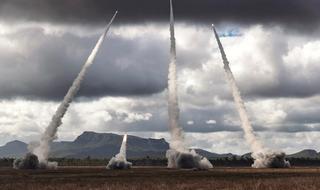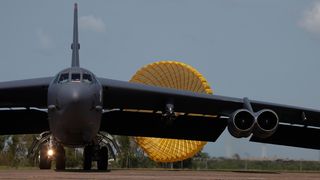Key takeaways
- Australia’s concerns over US extended nuclear deterrence are primarily about entrapment, not abandonment. Still, Australian policymakers are aware that Canberra needs to take on a greater share of the deterrence burden as part of alliance cooperation.
- Australian policymakers want to better understand the risks associated with greater nuclear cooperation. As they draw on a different Cold War legacy to other US allies, this legacy needs to be properly understood for further cooperation to be possible.
- Unique among America’s allies, statements about Australia’s understanding of US extended nuclear deterrence commitments are included in its Defence White Papers, but not in joint statements with the United States.
- Australia and the United States should begin discussing nuclear deterrence at the annual Australia-US Ministerial Consultations communiques to signal alliance cohesion, support its domestic legitimacy and enable more structured strategic dialogue.
- Both countries should identify where they agree on issues of deterrence, strategic stability and arms control. They should work with like-minded countries to engage China in relevant dialogues; and with Southeast Asian countries to understand and shape their perceptions of the role of deterrence and nuclear weapons in international and regional security.
- The alliance should consider cooperation in conventional long-range strike to reduce the reliance on nuclear weapons for deterrence and to signal that such cooperation might be expanded in extremis to involve nuclear weapons should Australia’s security environment deteriorate.
Introduction
In August 2019, the United States withdrew from the Intermediate-Range Nuclear Forces (INF) Treaty, paving the way for development of longer-range conventional and, possibly later, nuclear cruise and ballistic missiles that could target Russia or China from the territory of its allies in Europe and Asia. For many Australian observers, comments by US Secretary of Defense Mark Esper before the 2019 Australia-US Ministerial Consultations (AUSMIN) meeting that he would like the United States to deploy new land-based intermediate-range missiles in Asia “sooner rather than later” nonetheless appeared to come out of the blue.1 While Foreign Minister Marise Payne argued that Australia might be open to hosting such missiles, the Morrison government quickly emphasised that there was no formal request from the United States.2
How to use conventional and nuclear capabilities to deter and manage escalation of a conflict with China raises difficult questions for both the United States and Australia, and their relationship as allies.
How to use conventional and nuclear capabilities to deter and manage escalation of a conflict with China raises difficult questions for both the United States and Australia, and their relationship as allies. Both countries have been content, since the late 1960s, with the low profile of nuclear weapons in the alliance. Australia’s engagement with US nuclear deterrence has diverged significantly from that of other Cold War allies in Europe and Asia. Now, however, the United States is articulating in greater detail the relevance of nuclear weapons for the management of great power competition, while Australia has agreed to jointly examine how long-range US air and naval operations from Australia could support common allied interests in the Indo-Pacific. Both sides, therefore, need to pay greater attention to the way the other is approaching nuclear weapons in its defence thinking, and address the challenging question of how nuclear weapons might relate to their alliance cooperation.
Nuclear deterrence in US defence policy
Reducing the role and numbers of nuclear weapons in US national security strategy was a central objective of the Obama administration’s nuclear policy. The administration, however, also sought to strengthen regional deterrence and reassure allies and partners; and, with their cooperation, attempted to forge strategic stability with Moscow and Beijing.3 In Europe, these efforts translated into the reworking of the North Atlantic Treaty Organization’s (NATO) Strategic Concept, the 2012 NATO Deterrence and Defence Posture Review, and increased outreach in the NATO-Russia Council. In Asia, in response to growing concerns about North Korea and China, Washington established extended deterrence dialogues with its Northeast Asian treaty allies, Japan and South Korea. These dialogues sought to institutionalise sustained leadership focus on these issues and develop practical areas of cooperation, with some notable successes. Over time, for instance, the dialogue with Japan has enabled Tokyo to articulate its positions vis-à-vis US policy and posture with far greater confidence and detail that had hitherto been possible, leading to a closer alignment of Japanese capabilities, particularly in missile defence, with the broader US-Japan alliance framework.4
America’s reinvigoration of deterrence was thus well underway before the international security environment deteriorated due to Russia’s 2014 annexation of Crimea, North Korea’s renewed nuclear provocations and China’s increasingly confrontational foreign policy. These developments led the Obama administration to further strengthen reassurance and regional deterrence, in the process condemning Russia’s violation of the INF Treaty as NATO refocused on collective defence and the role of nuclear forces in its deterrence posture. Meanwhile, in Asia, Washington deepened its emerging extended deterrence work with Japan and South Korea.
Washington’s goal is to dissuade Russia, China and North Korea from seizing territory in their regions as part of a fait accompli strategy and from employing their nuclear forces — through coercion or actual use — in order to terminate a limited conflict on their terms.
The Trump administration’s 2018 Nuclear Posture Review (NPR) further expanded these efforts. It no longer describes US relationships with Moscow and Beijing as potentially positive and, while stressing that the United States “does not wish to regard either Russia or China as an adversary and seeks stable relations with both”, focuses on ways to sharpen deterrence against both great powers and “rogue states” such as North Korea.5 The NPR also re-emphasises the role of nuclear weapons in US national security strategy by developing “supplemental” capabilities such as low-yield Trident warheads and a new nuclear-armed cruise missile which, if funded, will be the first new US nuclear capabilities since the 1980s to provide additional flexible strike options. Moreover, as Russia moved from testing to deploying new intermediate-range cruise missiles in violation of the INF Treaty — and because China, a non-party to the Treaty, was unhindered by restrictions in developing its own intermediate-range systems — the Trump administration withdrew from the Treaty and commenced development of land-based conventional cruise and ballistic missile capabilities.
In short, Washington is examining ways to increase its nuclear and conventional capabilities to strengthen deterrence and manage escalation in possible great power war. Significantly, however, it continues to reject the notion of a limited nuclear conflict in its declaratory policy, providing an important element of continuity in US nuclear policy.6 Instead, Washington’s goal is to dissuade Russia, China and North Korea from seizing territory in their regions as part of a fait accompli strategy and from employing their nuclear forces — through coercion or actual use — in order to terminate a limited conflict on their terms.

In this context, Washington’s calls for US allies to assume a greater share of the deterrence and defence burden in their own regions have become more forceful than before, in large part because the United States no longer judges that it can address these challenges alone.7 This explains why Washington has become less focused on assuring its allies that US defence commitments are ironclad, and more concerned with eliciting their support in deterrence. The implications of this shift for the US-Australia alliance are profound. Indeed, this forms the backdrop for nascent discussions about the future prospect of basing INF-range missiles on Australian soil. For the United States, Australia is increasingly important to its overall force posture in Asia — and, in turn, to America’s ability to extend both conventional and nuclear deterrence to its regional allies.8
Cold War legacy: ANZUS, nuclear weapons, and the joint facilities
As Australia has not seen a reason to formally seek strengthened US nuclear guarantees in recent decades, the Cold War legacy continues to loom large in Canberra’s thinking on nuclear weapons. This legacy, however, is considerably different from NATO or US alliances with Japan and South Korea. In the 1950s and 1960s, Australia was keenly aware that it needed to gain a better understanding of the way the United States (and Britain) planned to employ nuclear forces in defence of Southeast Asia. It explored the possibility of gaining access to US and British warheads and pushed — with limited success — for greater US nuclear planning in the Southeast Asian Treaty Organization (SEATO). Yet, Washington never saw its interests sufficiently engaged in Southeast Asian security, SEATO or the Australia, New Zealand and United States Security Treaty (the ANZUS alliance) to justify granting Australia similar access to US nuclear warheads and integrated planning to that which developed inside NATO. Accordingly, Australian policymakers do not have the residual Cold War institutions that NATO members are now falling back on to negotiate cooperation on nuclear deterrence with the United States.
Australian policymakers do not have the residual Cold War institutions that NATO members are now falling back on to negotiate cooperation on nuclear deterrence with the United States.
China’s first nuclear test in 1964 created the prospect of a direct nuclear threat to Australia and led to more serious analysis of the costs and benefits of an Australian nuclear arsenal. In 1965, the US State Department assessed that although Canberra “will probably continue to rely on the US nuclear shield […] the growth of a Chinese or Indonesian threat might lead Australia to want to acquire such weapons itself, rather than being militarily dependent on the United States”.9 Australia’s flirtation with nuclear weapons at that time mirrored European concerns about the reliability of US guarantees under the new Kennedy administration, and peaked with the government of Prime Minister John Gorton, who was personally distrustful of relying on major powers and sceptical of US support for the Non-Proliferation Treaty (NPT).10
But Australia did not acquire its own nuclear weapons. In the early 1970s, the end of the Communist threat to Southeast Asia and US-Chinese rapprochement rendered any major threat to Australia remote. Under the Guam doctrine, the US expected Australia to provide for its own security, rather than contribute forces against a nuclear-armed China or the Soviet Union. Australia accepted that US Navy vessels transiting through its ports might be nuclear-armed, but Australian defence policy and planning lost any tangible connection with US nuclear operations in the region.11
Instead, Canberra’s involvement with US nuclear deterrence shifted to a global level as Australia began hosting important US command and intelligence facilities from the 1960s that engaged it directly in the operation of US strategic nuclear forces. This included a very-low-frequency communications station on the Northwest coast, and early warning and intelligence satellite control centres at Pine Gap and Nurrungar.12 While referred to as “joint facilities”, it was the Hawke government’s negotiation of complete Australian access in the 1980s that gave the principle of “full knowledge and concurrence” over their operation practical effect.13
Successive Australian governments accepted the risk of Soviet nuclear attack on these bases as Australia’s contribution to the US Cold War alliance. Because this would have effectively been an attack on the United States taking place in remote parts of Australian territory, it never raised concerns about extended deterrence credibility. Only after the Cold War, beginning with the 1993 Strategic Review, did Australian defence policy statements start to refer to extended nuclear deterrence, in statements directed as much towards Washington as potential adversaries.14 Until the 1995 Nye Report, which emphasised the importance of the US forward presence in Asia, a continued major US role in regional security did not seem a foregone conclusion.15 As such, highlighting the significance of US extended nuclear deterrence was a proxy for the importance Australia placed on the United States as a major stabilising factor in the Asian strategic order.
As the “joint facilities” remain the only substantial area of nuclear weapons cooperation in the alliance, “full knowledge and concurrence” has become the policy prism through which Australian officials consider any cooperation on extended deterrence, and the operation of conventional or dual-capable US forces from Australian territory.
In the 1994 White Paper, the Keating government stated that it “relied on the extended deterrence of the US nuclear capability to deter any nuclear threat or attack on Australia”.16 Since Australia mainly sought to underscore the importance it placed on the stabilising role of US alliances in Asia — rather than communicate an agreed understanding of the scope of US guarantees, or an agreed US-Australian concept for regional deterrence — Canberra did not align its statement to the more expansive US view of the role of its nuclear forces. Unique among America’s allies, Australian governments have been satisfied with an idiosyncratic arrangement whereby this and similar statements in Defence White Papers are promulgated by the junior partner, rather than by the United States or through joint statements.
Australia continues to regard the US alliance as an enabler of its own defence capabilities and an existential guarantee in extremis. But it now sees itself as a contributor to, rather than consumer of, regional security.17 As the “joint facilities” remain the only substantial area of nuclear weapons cooperation in the alliance, “full knowledge and concurrence” has become the policy prism through which Australian officials consider any cooperation on extended deterrence, and the operation of conventional or dual-capable US forces from Australian territory.18
Why is Australia becoming more interested in extended nuclear deterrence?
While few Australian policymakers have engaged with nuclear strategy in recent decades, there is a growing realisation amongst the country’s foreign affairs and defence community that nuclear deterrence will become more relevant for Australian defence policy. North Korea’s 2017 test of an intercontinental missile led to a short, if often ill-informed, public debate about Australia’s vulnerability to nuclear attack. For the first time since the 1980s, Australian ministers queried their senior officials about extended nuclear deterrence and how it applied to Australia. More importantly, Canberra has now realised that increased allied contributions are required if the United States is to play the long-term stabilising role in Asia that Australia seeks. Australia thus needs to consider how it might be willing to support those parts of US force posture and crisis management that complement nuclear weapons in regional deterrence and defence, if not hosting nuclear weapons directly.
Australia needs to consider how it might be willing to support those parts of US force posture and crisis management that complement nuclear weapons in regional deterrence and defence, if not hosting nuclear weapons directly
The implementation of the 2012 Force Posture Initiative, in which Australia and the United States agreed to expand the operation of US forces from Australia, has been hampered for years by long negotiations over cost sharing.19 But it is now resulting in US investment in Australian facilities that — in conjunction with Australian upgrades to its “bare bases” — will increase the ability of Australia’s northern air bases to host operations by American long-range air forces, including dual-capable bombers. Some officials also expect a significant US push to increase its presence in Australia should a future Corbyn Labour government return the British Indian-Ocean Territory, which hosts the large US base at Diego Garcia, to the Maldives.20 In addition to a significant stock of forward-positioned equipment, Diego Garcia supports B-52 bomber operations and is a forward-operating base for US guided missile submarines (SSGN).21
Australian policymakers are thus increasingly aware of the need to better understand the risks that may arise from increased support to America’s regional deterrence posture. Compared to US allies in Europe and Northeast Asia, Australian policymakers remain far less engaged with US declaratory policy or the consequence of particular US force structure decisions — such as the low-yield Trident warhead or the new nuclear submarine-launched cruise missile — for specific regional scenarios. Instead, as a country considering greater support to US operations in crises where nuclear weapons may come into play, concerns in Canberra focus on their implications for strategic stability, escalation and the US strategic role in Asia in general.
Washington’s abrogation of the INF Treaty has provided a significant impetus for Canberra’s interest in the evolving US deterrence posture. The consequences of the Treaty for security in Europe are of relatively little importance to Australia, but Canberra has not missed that the United States may now field new intermediate-range capabilities in Asia, and that significant changes to US force posture in Asia seem to be in the works. For the first time in decades, this means Canberra needs to consider three major issues: the effect of new capabilities for strategic stability, including what “strategic stability” in Asia might look like; the possibility that the United States may request permission to deploy conventional (and, perhaps later, nuclear) forces to Australia; and the cost and opportunities that possible US requests for operational cooperation (e.g., targeting) on such capabilities may entail.
Challenges to closer cooperation
Yet significant challenges remain to realising closer deterrence cooperation. Nuclear weapons are a politically challenging issue: Had the Labor Party won the last election, it would have had to deal with significant support from within the party for signing the new Treaty on the Prohibition of Nuclear Weapons. While during the election campaign Shadow Ministers Penny Wong and Richard Marles highlighted the serious shortcomings of the so-called Ban Treaty,22 new Labor leader Anthony Albanese is on the record as supporting Australia’s ratification.23 Support for nuclear disarmament remains a strong part of Labor Party folklore that is not counter-balanced by the experience of Russian nuclear coercion, which has led many European governments to judge that now is not the time for unilateral nuclear disarmament. This is not to say that any future Australian Labor government would emulate New Zealand and let nuclear issues become a breaking point for the alliance. The Labor Party supports the ANZUS alliance. But defending even the status quo around nuclear issues in Australia would consume political capital and policy attention.

Internationally, Canberra remains concerned that the presence of US Marines in Darwin has been an irritant in relations with Indonesia for longer than anticipated, and that Indonesia’s reaction to visibly greater support by Australia for America’s regional deterrence posture may complicate closer cooperation with Jakarta.24 For Australia, it is always easier to focus security cooperation with the United States on areas outside the public eye, be that intelligence, the “joint facilities”, space situational awareness or cyber operations. The essence of deterrence, however, is communication; and while Canberra is relatively comfortable with close cooperation with the United States, using this cooperation to signal Australian support for specific US deterrence commitments would be a major step change for Australia’s strategic policy.
Australian policymakers are aware that there is little experience in Canberra in developing policy on nuclear deterrence,25 nor are there threats to Australia that would cause the political class to push for more explicit commitments from the United States. Discussions about deterrence arise as part of Australia’s engagement with US Indo-Pacific Command, Strategic Command, and the US Defense and State Departments, but Australia’s takeaways from these do not always align in detail and emphasis.26 Moreover, Australian understandings of US policy do not always align with Japanese understandings, as conveyed by Tokyo.27 Accordingly, many Australian policymakers do not believe that US thinking about the role of nuclear weapons in managing great power conflict in Asia is sufficiently specific for Australia to understand the implications of cooperation on long-range conventional or nuclear strike.28
At the same time, however, US attempts to engage Canberra in a deterrence dialogue that could address some of these concerns date back to the last year of the Obama administration. Australian policymakers have been concerned that entering into detailed discussions with Washington on this issue could encourage unwanted planning assumptions on the part of US officials. (This might arguably also be a consequence of the focus on “full knowledge and concurrence” that draws consideration of deterrence cooperation to the relatively narrow remit of US operations from Australia.) What this means is that sustained discussions that might bring about leadership focus and develop expertise on deterrence challenges, policy and posture — and which now exist inside NATO and with South Korea and Japan — have yet to develop between the United States and Australia.29
While fears of abandonment often attract the most attention in public debate, apprehension about potential entrapment in America’s deterrence enterprise also runs deep in the thinking of Australian policymakers.
Overall, Australian policymakers are only just beginning to articulate, let alone reconcile, the partly conflicting objectives which they want from US extended nuclear deterrence in Asia: namely, guarantees that are seen as credible by US allies, North Korea and China, but that preferably do not attract greater public attention to the role of nuclear weapons.30 Australia does not want allied regional defence posture to be overmatched conventionally, but nor does it want to see lower nuclear thresholds. Australia seeks greater insight in the nuclear aspects of US posture, and “concurrence” if US strike forces operate from Australia, but Canberra has also eschewed the sort of greater institutionalisation of alliance cooperation that could give this practical effect. While fears of abandonment often attract the most attention in public debate, apprehension about potential entrapment in America’s deterrence enterprise also runs deep in the thinking of Australian policymakers.
Conclusions and recommendations
The scope for closer association between Australia and the United States in deterring great power conflict in Asia is greater than it has been in decades.31 Australia is less affected by the North Korean nuclear program than the United States, South Korea or Japan. But Canberra and Washington share a view of China as the main regional threat. Both allies have laid the groundwork for US long-range air operations from Australia, and both realise that significant change in posture and policy may be necessary to maintain deterrence and strategic stability in the Indo-Pacific.
Still, allied agreement on the need for deterrence does not erase different perspectives on the relative costs and benefits this would entail. To date, the “joint facilities” are the only domain relating to nuclear weapons where US and Australian assessment of these costs and benefits overlap sufficiently to enable practical cooperation. Neither Australia nor the United States are so far seeking deployment of US nuclear weapons to Australia, but this does not mean that the current limited role of nuclear weapons in the alliance exhausts the potential for further cooperation.
Such cooperation can be grouped into four areas:
- First, Australia and the United States should include statements about the value and role of nuclear deterrence in their annual AUSMIN communiques. Such statements are valuable because they create a need to engage on underlying policy assumptions and help frame discussions during crises. They would reinforce general deterrence by demonstrating that allies are considering the demands arising from great power conflict at the most senior levels of government. They could also provide a narrative of US nuclear restraint in the face of Chinese nuclear modernisation that could help counteract arguments put forward by advocates of the Ban Treaty. Each AUSMIN meeting would build on, adapt, or expand the language agreed the year before.32 Because negotiating text for communiques is of relatively limited scope, this could also lead Washington and Canberra to find merit in opening a regular strategic deterrence dialogue.
- Second, Australia and the United States should discuss their respective views on strategic stability and the role of arms control in international security and identify where they agree on new initiatives. Any successor regime to the INF Treaty would need to include China, providing a basis for strategic dialogue with Beijing, and perhaps the prospect of achieving confidence-building measures. Other existing regional security processes could be used to broaden such discussions, such as the Australia-US-Japan Trilateral Strategic Dialogue, partner engagement with the NATO Arms Control and Disarmament Committee, and perhaps in time the Quadrilateral Security Dialogue. In addition, Track-1.5 dialogues can help support this work and build public awareness in Australia, notably on the problems inherent in using the Ban Treaty as the main instrument to manage nuclear weapons.
- Third, Australia and the United States should draw out the views of Indonesia and other Southeast Asian countries regarding a more explicit posture of regional deterrence, including the role of nuclear weapons in international stability. This could include bilateral dialogue and fostering Track 1.5 and Track 2 engagements with their security communities on the management of regional stability, including the role of deterrence and nuclear weapons. As the primus inter pares in the Association of Southeast Asian Nations, how Indonesia reacts towards competing narratives of strategic stability from Washington and Beijing is crucial not just for Australia, but also to the success of the United States in nesting its regional deterrence in a narrative for Indo-Pacific stability.33
- Fourth, Australia and the United States should explore practical and public cooperation in conventional long-range strike operations that reduces the need for nuclear use by redressing conventional imbalances, but which also signals the possibility that Australia may consider increased cooperation, including and in extremis in relation to nuclear forces, should China significantly raise the threat to Australia and the region.34 Australian Joint Strike Fighters could, for example, provide suppression of enemy air defences for US long range bombers in exercises in the United States, which would signal the option of moving such cooperation to occur in Australia itself. Australian-US cooperation in the development of long-range targeting capabilities to enable US strike operations, including by new US intermediate-range cruise and ballistic missiles, could serve the same purpose. While the detail of this work would have to take place in the classified domain, there would be scope for it to be demonstrated and publicised, such as the targeting of US cruise missiles based on Australian sensors.








